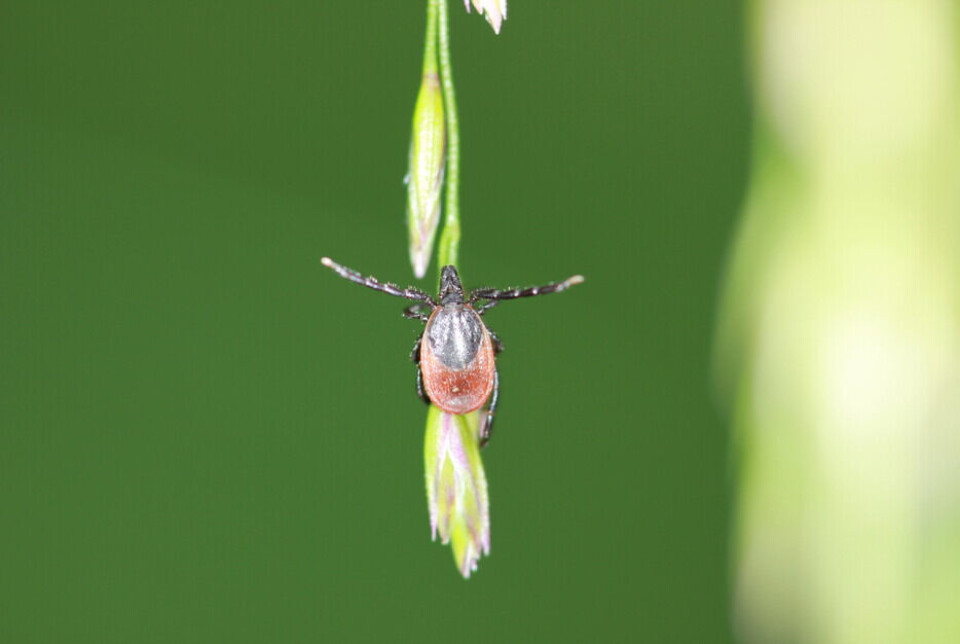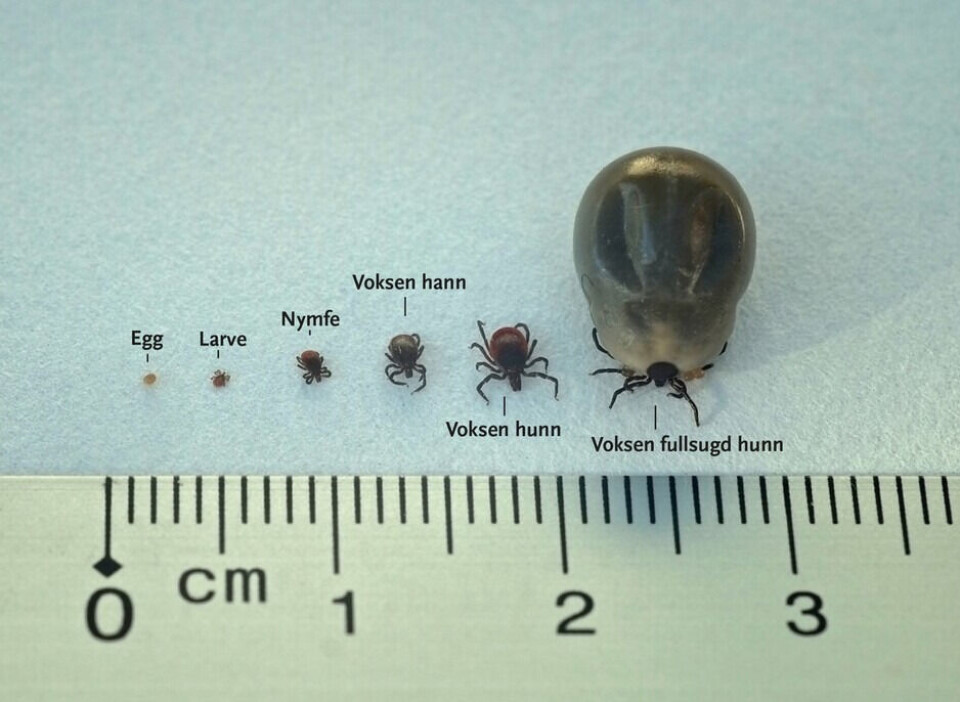THIS CONTENT IS BROUGHT TO YOU BY THE University of Agder - read more

It’s tick season. The bloodsucker only feeds three times throughout its life
The tick is a parasite that feeds on blood. It has a lifespan of two to eight years and spends most of its time waiting.
The tick waits to transform from a larva to a nymph after its first meal. It waits to become an adult after the second meal.
The third meal is the last one.
The tick larva is a tiny tick, not elongated like a butterfly larva, but as small as the smallest dot you can make with a pencil. As soon as it has eaten its fill, it falls to the ground. After a while, it goes dormant to develop into a nymph.
The nymph goes through the same cycle: finds a meal, falls to the ground, goes dormant, and transforms into an adult.
Sucks blood while mating
Between meals, the tick waits to mate. The male tick waits for a potential mate in the fur of an animal. And while the female tick feeds on blood, the male takes the opportunity to mate.
After mating, the female waits a few days before laying around 1,000 eggs. Then its life tasks are fulfilled. It dies, and new ticks are on their way.

Every spring and summer, headlines appear in the newspapers. The tick has become bigger. It has become more dangerous. And now it's coming to get you.
Myths about ticks
Associate professors Randi Eikeland and Vivian Kjelland at the University of Agder are experienced tick researchers.
Eikeland is a doctor and neurologist, and a specialist in tick-borne diseases. Her research is particularly concerned with how Lyme disease affects the nervous system.
Kjelland is a molecular biologist, tick researcher and has, among other things, studied which pathogens ticks carry.
The researchers' reassurances:
- No, the tick hasn’t gotten bigger.
- No, it can't fly.
- No, it can't jump.
- No, it won't come after you.

The tick researchers tell us there are things we should be aware of:
- Yes, ticks can carry bacteria and viruses that could cause serious illnesses.
- Yes, you have to grab it and pull it out to get rid of it.
- No, it cannot be brushed away like a mosquito, ant, or fly.
- No, it cannot be washed off in the shower.
- No, it won't die and won't let go if you go swimming in the sea.
- No, it doesn’t die after sucking blood. It falls to the ground, and if it is not already an adult, it transforms into a nymph or an adult tick.
- Yes, it will survive in the washing machine if you wash your clothes at 40 degrees Celsius or less.
- Yes, the male also sucks blood, but less than the female. The male will roam around more on its host because it is looking for a female tick to mate with.
In forests and gardens
The tick lives in the forest. It likes moist deciduous woodland and tall grass, but also open grassland and heather.

You can easily find ticks in your garden too. Especially along the coast in Eastern Norway, Agder, and Rogaland, there are a lot of ticks. The tick season is from April to September.
Pets may crawl into bushes and thickets and bring them home with them.
Headless spider that feeds on blood
The tick has no eyes or nose. It has a 'biting tool' where other arachnids have a head.
Kjelland points out that it is not an insect. The tick is a parasitic arachnid.
It feeds on the blood of mammals, birds, and reptiles. It needs blood in its intestines to survive and grow.
Anesthetise before biting
The tick sits on a blade of grass or in the shrubs. There it waits to grab hold of somebody passing by.
It will gladly take a man's foot if it can get hold of one. Or a woman's foot. Mouse. Toad. Hare. Roe deer. Moose. Blood is blood to the tick.
With the claws on the front two of its eight legs, it grabs hold of its prey. It quickly crawls to an area to bite, preferably where the skin is thin. The knees, inner thighs, neck, and behind the ear are popular areas. It attaches itself and sucks blood.
“You often notice it when it crawls on your skin, especially if it is an adult tick. But you won’t notice when it bites. It will numb the bite site so that it can suck blood in peace,” Kjelland says.
Senses with its front legs
Without eyes and a nose, the tick is dependent on sensing its surroundings. It senses with a sensory apparatus on the forelegs which is called Haller's organ.
The sensory organ helps the tick to sense smells and vibrations in the air. It also has some areas on its back, so-called photoreceptors, which help it distinguish between light and dark.
“They probably suck day and night once they have attached themselves to the prey,” Kjelland says.
Tick bites do not cause itching. This is to help the tick avoid being scratched away. The goal is to consume blood while it is attached to the prey and before the prey notices the tickling sensation.
Infection from ticks
The tick sucks blood and regurgitates excess blood (plasma). As it reguritates the plasma and its own saliva, the prey can become infected with Lyme disease, other bacteria, and the TBE virus (tick-borne encephalitis).
Bacteria and viruses that the tick has ingested from mice and other animals can be transmitted to humans. Every year, 4-500 people in Norway become ill with Lyme disease.
The TBE virus usually causes illness in around 40-50 people annually. However, last year, over 80 people fell ill.
“Both diseases can cause serious symptoms and long-term suffering. It is therefore important to be aware of ticks and take the necessary precautions,” Eikeland says.
Attacks the nervous system
Lyme disease attacks the peripheral nervous system and affects the arms, legs, skin, and muscles. The disease can be cured with antibiotics.
The TBE virus attacks the central nervous system, the brain, and spinal cord. The virus cannot be treated with antibiotics or other medications
Randi Eikeland has studied the effects of tick bites on humans since 2004. She recommends vaccination against the TBE virus for those who are exposed to many tick bites and live on the coast from the Swedish border in Halden to Flekkefjord.
The vaccine requires a prescription from your general practioner, and Eikeland points out that it does not protect against ticks or Lyme disease, so daily tick checks are still necessary.
“In Austria, they’ve had a vaccination programme against TBE for several years, starting from when children are one to two years old. This has led to fewer people being infected with the TBE virus in Austria,” Eikeland says.
Reference:
Halperin et al. 'Lyme neuroborreliosis: known knowns, known unknowns', Brain, 2022. DOI: 10.1093/brain/awac206 (Abstract)
Kjelland et al. Fakta om flått: alt du må vite for å unngå bitt, om symptomer, bendling og fjerning av flått (Facts about ticks: everything you need to know to avoid bites, about symptoms, treatment, and tick removal), Kagge Forlag, 2014. (Summary in Norwegian)

This article/press release is paid for and presented by the University of Agder
This content is created by the University of Agder's communication staff, who use this platform to communicate science and share results from research with the public. The University of Agder is one of more than 80 owners of ScienceNorway.no. Read more here.
More content from the University of Agder:
-
Research paved the way for better maths courses for multicultural student teachers
-
The law protects the students. What about the teachers?
-
This researcher has helped more economics students pass their maths exams
-
There are many cases of fathers and sons both reaching elite level in football. Why is that?
-
How we used plants to protect ourselves from evil
-
What is it like for nurses to promote health behind bars?




































